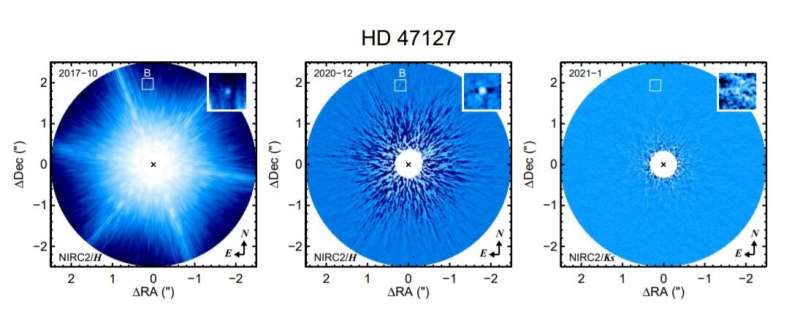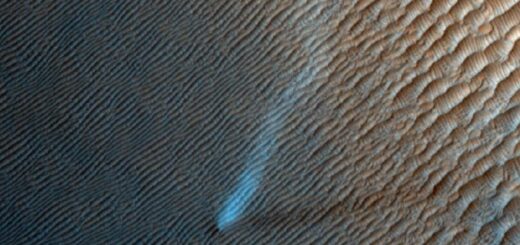Astronomers detect substellar companion of HD 47127

Using the Harlan J. Smith Telescope, astronomers have discovered that the star HD 47127 has a substellar companion. The newly identified object, designated HD 47127 B, appears to be a brown dwarf or a brown dwarf binary. The finding is reported in a paper published May 4
Brown dwarfs are intermediate objects between planets and stars. Astronomers generally agree that they are substellar objects occupying the mass range between 13 and 80 Jupiter masses. One subclass of brown dwarfs (with effective temperatures between 500 and 1500K) is known as T dwarfs, and represents the coolest and least luminous substellar objects so far detected.
Located some 86.8 light years away, HD 47127 is an old sun-like main sequence star of spectral type G5. The star is slightly metal-rich and has a mass of about 1.02 solar masses. Its age is estimated to be between 7 and 10 billion years.
Previous observations of HD 47127 have suggested that this star may harbor a companion on a wide orbit. Now, a team of astronomers led by Brendan P. Bowler of the University of Texas at Austin, has analyzed the data from a long-term monitoring (between 2001 and 2021) of HD 47127 with the Tull Coude spectrograph at McDonald Observatory’s 2.7-m Harlan J. Smith telescope. The results, complemented by the data from the Keck Observatory, confirm the presence of a substellar companion.
“We present the discovery and dynamical mass measurement of a substellar companion to HD 47127, an old (≈7–10 Gyr) G5 main sequence star with a mass similar to the sun. Radial velocities of the host star with the Harlan J. Smith Telescope uncovered a low-amplitude acceleration of 1.93 ± 0.08 m s−1 yr−1 based on 20 years of monitoring. We subsequently recovered a faint (∆H=13.14 ± 0.15 mag) co-moving companion at 1.95′′ (52 AU) with follow-up Keck/NIRC2 adaptive optics imaging,” the researchers explained.
The system was found to have a long orbital period, approximately 610 years, as HD 47127 B is separated from HD 47127 by some 74 AU. The orbit turned out to have a modest eccentricity of 0.20 and an inclination of around 62 degrees.
The observations indicate that the mass of HD 47127 B should be within the range of 68-177 Jupiter masses. This value rules out the possibility that this object is a white dwarf, leaving the brown dwarf scenario the most plausible.
The astronomers noted that the parameters of the HD 47127 system suggest that the newly found companion could be a late T dwarf between 68 and 78 Jupiter masses. However, if it’s at least 100 times more massive than our solar system’s biggest planet, it could be a binary pair of brown dwarfs.
“Another possibility that could account for the unusually large maximum likelihood value of 103 MJup from our orbit fits is if HD 47127 B itself is a close unresolved binary, such as a pair of ≈50+50 MJup T dwarfs. Evolutionary models can be used to assess whether this binary hypothesis is plausible given the absolute magnitude and age of HD 47127 B,” the researchers wrote.
They added that it is also possible that another unseen close-in companion could be present in HD 47127. Further observations of the system are required in order to verify this assumption.



 Creators of mankind
Creators of mankind Description of “Tall white aliens”
Description of “Tall white aliens” Where they came from?
Where they came from? About hostile civilizations
About hostile civilizations The war for the Earth
The war for the Earth “Tall white aliens” about eternal life
“Tall white aliens” about eternal life Video: “Nordic aliens”
Video: “Nordic aliens” Aliens
Aliens Alien encounters
Alien encounters The aliens base
The aliens base UFO
UFO Technology UFO
Technology UFO Underground civilization
Underground civilization Ancient alien artifacts
Ancient alien artifacts Military and UFO
Military and UFO Mysteries and hypotheses
Mysteries and hypotheses Scientific facts
Scientific facts


















